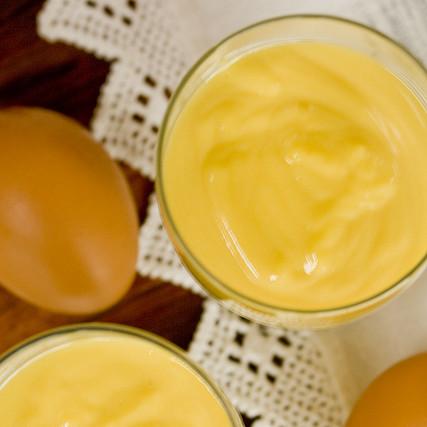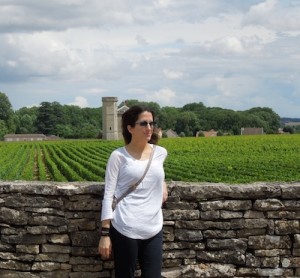 The first dish I remember eating is what they call in Croatia zbaceno jaje. In neighboring Italy, it’s known as zabaglione. The dish is simple: raw egg yolks and equal parts sugar beat vigorously by hand or with an electric mixer, until the mixture is light and frothy. It would be served in a glass, or—as was my grandmother’s preference—in a mug. Sometimes grated dark chocolate adorned the top. Served thus, it could be mistaken for a cappuccino. And yet there was that unmistakable yellow tinge. Like pale gold.
The first dish I remember eating is what they call in Croatia zbaceno jaje. In neighboring Italy, it’s known as zabaglione. The dish is simple: raw egg yolks and equal parts sugar beat vigorously by hand or with an electric mixer, until the mixture is light and frothy. It would be served in a glass, or—as was my grandmother’s preference—in a mug. Sometimes grated dark chocolate adorned the top. Served thus, it could be mistaken for a cappuccino. And yet there was that unmistakable yellow tinge. Like pale gold.
My twin sister and I must have been six years old. Along with our two older sisters, we were spending the summer with our grandparents in their home in the seaside village of Kastel Luksic, Croatia. I remember arriving each year: we would race into the house, and the first thing we would see was the white stone staircase with a long black-and-white runner down its length. We’d run up to our guestroom—wallpapered green, with black-and-white photos of our grandparents hanging on the walls and four single beds arranged around a highly lacquered wooden coffee table adorned by lacework. On the mantle, our grandparents kept photos of us, their granddaughters who otherwise resided in Chicago.
In the mornings we’d sleepily pad down the stairs and head to the kitchen, where lingered the faint smell of soap from the washed floor, whose red and white tiles felt smooth and cool under our feet. The light would have a way of coming into this kitchen and loaning a heavenly quality to everything we did there—lightening everything, as if our present was played out on overexposed film. With grandfather either working in the orange grove just past the kitchen window or behind the house in the vegetable garden, everything felt wonderfully in place. The kitchen was a place for women, and there was something comforting about this to me.
On this particular morning—the morning of my first food memory—my grandmother handed to my twin sister and me a ceramic mug and a spoon. “Provajte ovo,” she said. Try this. The light behind her gave her a celestial glow, as if she were an angel.
I looked at the soft peak of barely yellow froth. The pale, smooth consistency appealed to me visually, as if what I was about to eat might taste like ice cream. My sister and I dipped our spoons in with twin-like synchronicity and a moment later looked at each other with wide smiles, knowing we’d discovered something new and wonderful. The flavor was like custard, with sugar granules providing a candied texture to the smooth dish. There was airiness too—air folded in with the egg and sugar, making a sugar-cloud. The name that Croats gave this dish, zbaceno jaje, literally translates to “cast down,” or “thrown,” eggs—capturing the notion of air and movement. Though for me, they were cast upward to a higher purpose.
My mother tells me the key to this recipe is the fresh egg, a simple luxury we had in Croatia. My grandparents’ farm was a short stroll from the house, in the direction away from the sea and toward the mountains. As much as I loved going to the farm to watch the pigs, I hated the henhouse. I remember it as a small wooden shack, with an elevated perch that ran along its interior. The hens—there may have been ten of them—sat roughly equidistant from each other on this perch, their throne. They looked at us arrogantly when we walked through the rickety door, as if they knew that they provided something of great value to us. Picking up one of the proud hens to find an egg was an endeavor that brought me great anxiety. It was all erratic wing flapping and beady eyes that were scared and irritated at the same time. My sister and I would make it a team effort, with one of us grabbing the hen and the other quickly collecting the bounty.
With the warm eggs in our pockets and the rickety door shut behind us, the relief was something I don’t think I’ve subsequently matched in life. We’d walk back to the house as merry children again, and could almost taste another round of zbaceno jaje.
Eggs, sugar, and air. The simplicity of it is what stands out now, in hindsight. The dessert, for me, will always be endemic to a country whose way of life was a revelation of simplicity. I remember not only the mornings and the light in the kitchen window, but the nights too and the brightness of the stars. My sisters and I liked to climb up an exterior stone staircase to the flat stone roof of a building adjoining the main house, where we would lie on our backs and stargaze. On this roof is where my grandmother would hang the laundry to dry. If a breeze came, the white tablecloths and bed sheets would snap into our line of sight as we lay on the ground.
Today, recipes for zbaceno jaje—usually under the Italian nomenclature zabaglione—carry with them triangular icons denoting caution should be taken. Consumption of raw eggs carries the risk of salmonella. I know that the risk can be avoided, if the eggs are pasteurized or cooked gently in a bain marie, or double boiler. And yet I can’t bring myself to make the dish; I can’t bring myself to combine eggs, sugar, and air. It may be that I know that it won’t ever taste like it did when I was a child in my grandmother’s kitchen. The air, and the light it carries, is just not the same.
 Maria Ivkovic Manuccia’s writing has appeared in Tampa Review Online (TRON) and received honorable mentions or semi-finalist status in competitions hosted by Glimmer Train Press, Arts and Letters, and SLS-Disquiet.
Maria Ivkovic Manuccia’s writing has appeared in Tampa Review Online (TRON) and received honorable mentions or semi-finalist status in competitions hosted by Glimmer Train Press, Arts and Letters, and SLS-Disquiet.
STORY IMAGE CREDIT: Flickr Creative Commons/Konstantina


